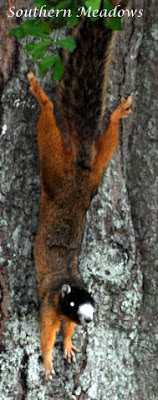Watching birds is one of my favorite ways to spend time outdoors during the winter months. When the trees stand stark and the temperatures drop, studying birds is much easier. I no longer have to search out the birds to view their behavior, they come to me. Winter is certainly the hottest time for birding action in our garden.
 |
| Tufted Titmouse |
Once the insects have withdrawn for the winter. After the fruits and berries have been devoured from the trees and shrubs. When the seeds from native perennials, grasses and forbs are scarce, birds flock to the feeders.
Winter, especially February, can be a harsh time for birds.
Supplementing wild food sources with backyard bird feeders will bring
these special visitors closer to your home and may help them survive the
harshest season.
 |
| Ruby-crowned kinglet |
Offering several styles of feeders, each with a different type of seed, berry or fruit will attract a larger variety of birds. Project Feeder Watch has assembled a helpful
list of common feeder birds by region and what they like to eat.
 |
| Northern Cardinal (female) and White-throated Sparrow |
Early morning conversations at the feeders provide, not only great photo opportunities, but loads of entertainment. Song birds are especially busy in the early hours, filling up with high energy seeds after an arctic night. Birds store energy as fat and can only stock 16 to 24 hours of energy at a time. This is why early mornings and just before dark are the busiest feeding times. Often, birds have to wait patiently in line for a turn at the bustling buffet.
 |
| Eastern Bluebird and White-throated Sparrow |
And then there are some birds, like the red-bellied woodpecker, who just fly in and take command.
 |
| Red-bellied Woodpecker |
Winter is an excellent time to observe birds that don't normally frequent backyard feeders. I've noticed that bluebirds become braver and find the gusto to dash in and mingle with other song birds when temperatures are frigid.
 |
| Eastern Bluebird |
You can learn more about the special feeding needs of bluebirds in winter
here.
 |
| Eastern Bluebird (male) |
Robins are a common sight on lawns tugging at earthworms, but have you ever seen one visiting your feeder? Surprisingly, they are attracted to several different feeders including suet and hulled sunflower seeds. Try putting up a fruit or meal worm station and see if they come.
 |
| American Robin |
Some birds will collect seeds during summer and fall hiding them for times when food is more limited. I often observe woodpeckers caching sunflower seeds in tree cavities. They can only hope that other birds or animals don't find their stash.
 |
| Red-bellied Woodpecker |
Birds have extremely high metabolisms, and cold weather increases their caloric needs. The body temperature of birds, which ranges from 104 to 113 degrees Fahrenheit, determines how high their metabolism is. In winter, birds need to produce more heat to stay warm.
 |
| Eastern Bluebird (female) |
Some birds, such as the Carolina Chickadee, will go into nocturnal torpor, which lowers their body temperature, heart rate and breathing to conserve energy. This practice can save as much as 20% of their energy.
 |
| Carolina Chickadee |
Some song birds wear a much different coat in winter, than during breeding season, making them much less flashy. Take the American Goldfinch, who dresses down for winter in a drab olive cloak. A stark contrast to his bright canary yellow in summer.
 |
| American Goldfinch |
Like mammals, some birds will grow more feathers for winter to keep warm. The American Goldfinch has 1,000 more feathers in winter than summer. Smart bird!
Birds use their feathers to stay warm. You may observe birds perched on tree limbs, fences or in shrubs looking plump and pudgy. By puffing up their feathers, they trap in air allowing their body heat to warm up the air between their feathers and body, providing an additional layer of insulation against the cold.
 |
| Dove |
Birds will also sleep with their bill under their wing feathers to breathe in the warm air.
 |
| Hairy Woodpecker |
Constant shivering increases their body temperature (thermogenosis). This produces heat at 5 times their normal rate.
 |
| Hermit Thrush |
Now, you may be wondering about their exposed feet. Birds' feet are bones covered in a rough skin, which unlike humans' feet, contains very little water. The blood vessels in their legs are also designed to keep their feet warm. Arteries keep warm blood flowing from the heart down to their legs.
 |
| Pine Warbler |
Dehydration is actually a bigger threat to birds than starvation in winter.
Providing a heated bird bath will attract lots of birds to your garden
when fewer non-frozen water sources exist. In addition to drinking,
water is needed for preening feathers. Without proper
preening, feathers won't stay in position and aligned, causing gaps where
heat can escape, thus lowering the birds body temperature.
 |
| American Robin |
Backyard birders and feeder watchers like me can help document the diversity of birds in your area this weekend (February
12-15, 2016) by participating in the
Great Backyard Bird Count. This
citizen-science project helps document birds in rural, urban and natural areas. For more information on this engaging and educational
event click
here.
 |
| Downy Woodpecker |
With a little effort you can attract a diverse group of birds to your garden when little else is happening. Simply meeting birds' food, water and shelter needs can make winter your top birding season too.




















.png)
